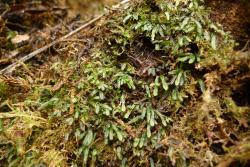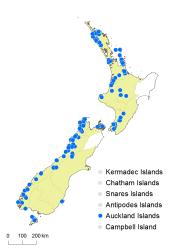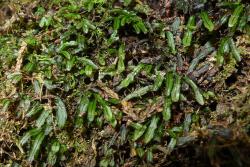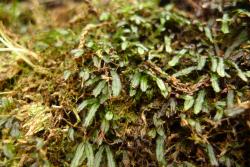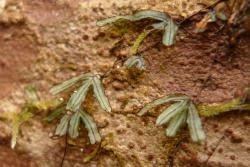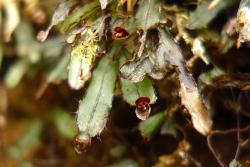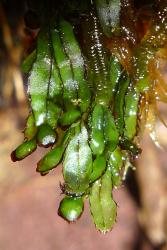- ≡ Trichomanes armstrongii Baker in Hooker & Baker, Syn. Fil. [Hooker & Baker] 452 (1868)
- ≡ Hymenophyllum cheesemanii var. armstrongii (Baker) Cheeseman, Man. New Zealand Fl. 938 (1906)
- ≡ Microtrichomanes armstrongii (Baker) Copel., Philipp. J. Sci. 73: 457 (1941)
- ≡ Craspedophyllum armstrongii (Baker) Rae ex Copel., Gen. Fil. 33 (1947)
- = Hymenophyllum cheesemanii Baker in Hooker, Hooker's Icon. Pl. 12, 30, t. 1132 (1873) – as cheesemanni
- ≡ Craspedophyllum cheesemanii (Baker) N.A.Wakef., Victoria Naturalist 66: 59 (1949)
- = Hymenophyllum melanocheilos Colenso, Trans. & Proc. New Zealand Inst. 17: 255 (1885)
Epiphytic or rupestral ferns. Rhizomes long-creeping, filiform, <0.1 mm diameter, glabrous or bearing scattered red-brown hairs <0.1 mm long. Fronds 4–32 mm long. Stipes 0.5–10 mm long, dark brown throughout, not winged, glabrous or with a few short scattered hairs. Laminae undivided or forked 1–3 times, dark green with dark brown midribs, membranous, glabrous; undivided laminae oblong or narrowly oblong or linear, 3–28 mm long, 1–3 mm wide; divided laminae elliptic or obovate or obtriangular, 4–25 mm long, 3–20 mm wide. Ultimate lamina segments oblong, 4–24 mm long, 0.9–2.5 mm wide; margins entire, bearing dark brown or blackish spines and sometimes with a distinct blackish border of elongated cells. Sori terminating lamina segments, solitary, partially immersed in lamina; indusia bivalvate; indusial flaps ovate, 1–2 mm long, apices obtuse, margins entire, sometimes with a dark brown or blackish border; receptacles included within indusial flaps.
Hymenophyllum armstrongii is recognised by its diminutive size, laminae with dark brown midribs and dark brown or blackish marginal spines, and solitary sori that terminate the lamina segments. It is easily overlooked, hidden among bryophytes, when growing epiphytically on tree branches.
North Island: Northland, Auckland, Volcanic Plateau, Taranaki, Southern North Island.
South Island: Western Nelson, Sounds-Nelson, Westland, Canterbury, Otago, Southland, Fiordland.
Stewart Island, Auckland Islands.
Altitudinal range: 10–1450 m.
Hymenophyllum armstrongii occurs in lowland to subalpine areas of the western and central parts of the North Island, from Kaitaia to the southern Rimutaka Range, but is absent from Gisborne and the entire east coast. It is uncommon below 300 m but reaches over 1300 m in the Tararua Ranges. In the South Island it is confined to western districts, occurring sporadically in the Marlborough Sounds and from north-west Nelson to Fiordland, with an outlying population in the Leith Valley, Dunedin. It extends from sea level near Haast to 1450 m in the Allen Range, north-west Nelson.
Occurs most frequently as an epiphyte at lower altitudes, often intertwined with mosses and liverworts, on the branches of a wide variety of forest trees, but it is also found forming mats on damp rock, in rock crevices and under overhangs at higher altitudes. It occurs under kauri, podocarp, beech and broadleaved forest and in subalpine scrub, herbfield and tussock grassland. It has been recorded growing on Agathis australis, Dacrydium cupressinum, Dacrycarpus dacrydioides, Halocarpus biformis, Lepidothamnus intermedius, Phyllocladus alpinus, P. trichomanoides, Podocarpus laetus, Prumnopitys ferruginea, Archeria racemosa, Ixerba brexioides, Knightia excelsa, Kunzea ericoides, Metrosideros excelsa, M. robusta, M. umbellata, Quintinia sp., Weinmannia racemosa, W. silvicola and species of Nothofagaceae, but never on tree fern trunks.
n = 13 (Lovis in Brownsey 1991; Lovis in Dawson et al. 2000).
The holotype specimen of Trichomanes armstrongii at K is a fragment only. There is a more complete specimen collected by J.B. Armstrong from the Black Range, Canterbury in March 1867 (WELT P006098), which may be the source of the material sent to Kew, but which cannot be definitely identified as an isotype.
Hymenophyllum melanocheilos was described by Colenso (1885) from collections made at Whangaroa, County of Mongonui [Mangonui] in 1884 by R.W. Rowson.The lectotype was chosen by Allan (1961), citing "woods, Whangaroa, R.W. Rowson" in WELT (now WELT P003295). There is a syntype in the Cheeseman herbarium (AK 139868). Both specimens bear the date 1885, rather than 1884 given in the protologue, and one or other date is assumed to be incorrect.



